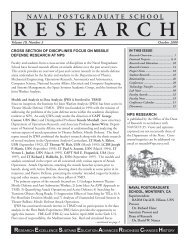Spectral Unmixing Applied to Desert Soils for the - Naval ...
Spectral Unmixing Applied to Desert Soils for the - Naval ...
Spectral Unmixing Applied to Desert Soils for the - Naval ...
You also want an ePaper? Increase the reach of your titles
YUMPU automatically turns print PDFs into web optimized ePapers that Google loves.
small concentrations making <strong>the</strong>m un-useful <strong>for</strong> target detection. If, however, higher<br />
resolution imagery were available it may still prove <strong>to</strong> be a useful target based on <strong>the</strong> fact<br />
that positive hits were detected and BSCs were found <strong>to</strong> exhibit similar changes in<br />
spectral characteristics as soils when exposed <strong>to</strong> impact-related surface disturbances.<br />
What seems, at this point <strong>to</strong> be <strong>the</strong> most successful test, was <strong>the</strong> disturbed creek<br />
soil endmember in <strong>the</strong> f110623t01p00r10 data set. This was a bit of a surprise because<br />
<strong>the</strong> expectation was that <strong>the</strong> higher resolution imagery would be more successful which is<br />
why it was utilized <strong>for</strong> both <strong>the</strong> initial and repeatability tests. The lower resolution<br />
imagery was only utilized when results in <strong>the</strong> repeatability test were <strong>to</strong>o inconclusive <strong>to</strong><br />
be considered a valid test and fur<strong>the</strong>r testing was required. The fact that <strong>the</strong><br />
f110512t01p00r08 data set was not successful and <strong>the</strong> f110623t01p00r10 was can also<br />
serve as a positive reflection on <strong>the</strong> test. The issue was that <strong>the</strong> distribution of positively<br />
identified pixels was confined <strong>to</strong> steep slopes <strong>for</strong> <strong>the</strong> most part with a few in what looked<br />
like runoff areas in <strong>the</strong> higher resolution data set.<br />
This could mean that <strong>the</strong> circumstances creating <strong>the</strong> spectral characteristics<br />
specific <strong>to</strong> <strong>the</strong> disturbed creek endmember were not present in <strong>the</strong> imagery. This <strong>the</strong>ory<br />
is fur<strong>the</strong>r supported by <strong>the</strong> lack of a substantial creek feature within <strong>the</strong> 110512t01p00r08<br />
imagery. The f110623t01p00r10 data set however, had several features that appeared <strong>to</strong><br />
be drainage basins. The result was significant successful identification of areas that<br />
appear <strong>to</strong> be drainage basins with OHV trails in <strong>the</strong>m not always visible in <strong>the</strong> imagery.<br />
In almost every case, a pixel with a value between 5-11% was a positive match <strong>to</strong> an area<br />
with an OHV trail or a drainage basin. While 5-11% seems a lower range than o<strong>the</strong>r data<br />
sets, one must remember <strong>to</strong> take in<strong>to</strong> account <strong>the</strong> fact that a larger pixel size means<br />
similar features will take up less of a percentage than in smaller pixels. The positive<br />
identification range is consistent with <strong>the</strong> expected percentage of a pixel that a trail/OHV<br />
route should occupy.<br />
C. COLOR COMPOSITES<br />
Color composites using <strong>the</strong> user supplied endmembers in conjunction with<br />
imagery derived endmembers provided useful results. While <strong>the</strong> composites illustrate<br />
78
















